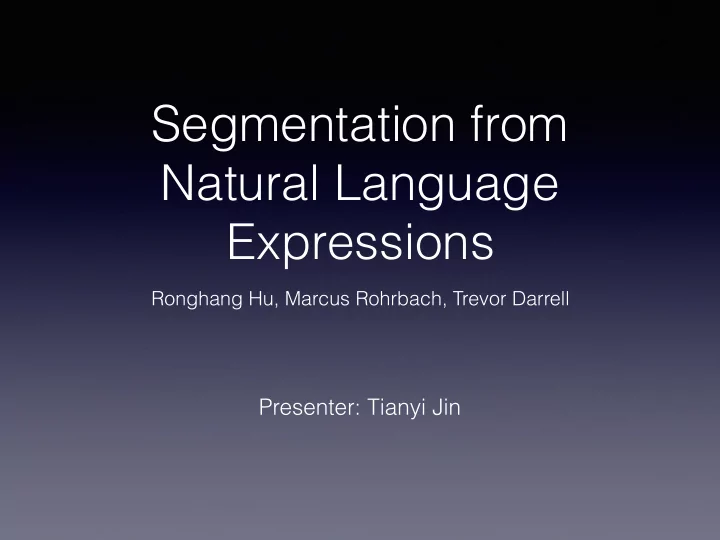

Segmentation from Natural Language Expressions Ronghang Hu, Marcus Rohrbach, Trevor Darrell Presenter: Tianyi Jin
Comparisons between different semantic image segmentation problems (f) Natural Language Object Retrieval: bounding box only, non (e) Grabcut: generate a mask over the pixelwise foreground (or the most salient) object
Overview Goal: Pixel-level segmentation of image, based on natural language expression
Related Work • Localizing objects with natural language - bounding box only • Fully convolutional network for segmentation - used for feature extraction and segmentation output • Attention and visual question answering - only learn to generate coarse spatial outputs, with other purposes
Our Model A Detailed Look At 👁
Spatial feature map extraction • Fully convolutional network - Input image size: W x H , spatial feature map size: w × h , with each position on the feature map containing D im channels ( D im dimensional local descriptors) • Apply L2-normalization to the D im dimensional local descriptor - Extract a w × h × D im spatial feature map as the representation for each image • Add extra channels of x, y coordinate of each spatial location - Get a w × h × (D im +2) representation containing descriptors and spatial coordinates • In this implementation: VGG-16 with treating fc6, fc7 and fc8 as convolutional layers, which outputs D im = 1000 dimensional local descriptors. • Resulting feature map size: w = W/s and h = H/s , where s = 32 is the pixel stride on fc8 layer output. (Here W = H = 512 )
Encoding expressions with LSTM network • Embed each word into a vector through a word embedding matrix • Use a recurrent Long-Short Term Memory (LSTM) network with D text dimensional hidden state to scan through the embedded word sequence • L2-normalize • In this implementation: LSTM network with D text = 1000 dimensional hidden state
Spatial classification and upsampling • Fully convolutional classifier over the local image descriptor and the encoded expression - Tile and concatenate hidden state to the local descriptor at each spatial location in the spatial grid -> a w × h × D’ (where D’ = D im +D text +2 ) spatial map - Train a two-layer classification network (two 1 x 1 convolutional layers), with a D cls dimensional hidden layer, which takes at input the D’ dimensional representation -> a score indicating whether a spatial location belong to the target image region or not - In this implementation: D cls = 500 • Upsampling through deconvolution - a 2 s × 2 s deconvolution filter with stride s (here s = 32) - Produces a W × H high resolution response map that has the same size as the input image
Loss Function
Experiments • Dataset: ReferIt [1] • 20,000 images. 130,525 expressions annotated on 96,654 segmented image regions. - Here: 10,000 images for training and validation,10,000 images for testing - contains both “object” regions (car, person, bottle) and “stuff” regions (sky, river and mountain) • Baseline methods - Combination of per-word segmentation - Foreground segmentation from bounding boxes - Classification over segmentation proposals - Whole image [1] Kazemzadeh, S., Ordonez, V., Matten, M., Berg, T.L.: Referitgame: Referring to objects in photographs of natural scenes (EMNLP 2014)
Evaluation • Two-stage training strategy: - Low resolution version: w × h = 16 × 16 coarse response map - High resolution version: upsampled from low resolution model, predict W × H high resolution segmentation • Overall IoU: total intersection area divided by the total union area • Precision: the percentage of test samples where the IoU between prediction and ground-truth passes the threshold
Results
Questions?
Thank you!
Recommend
More recommend